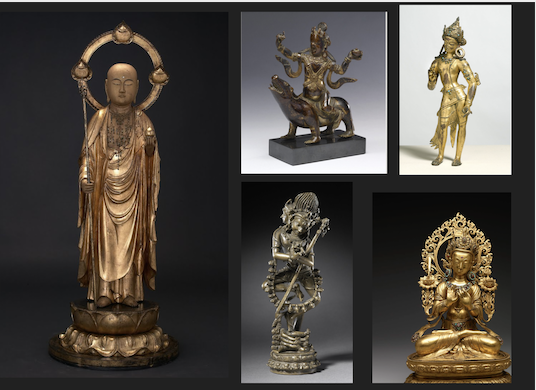
Overview:
Throughout almost all religions across the world, an innumerable amount of deities exist, spanning polytheistic and monotheistic institutions alike. These deities are frequently depicted in some form of religious artwork. For my final exhibition project, I wanted to take a closer look at some of the deities within Buddhism, uncovering their values and investigating their purpose within the religion. Furthermore, I wanted to use a close up examination of Buddhist deities to see if they could lend insight to the wider use and influence of art across other religions. In other words, I wanted to ask these questions: Why do religions exist? Why do almost all religions have some form of deities? Why are deities and other religious topics so frequently depicted in artwork?
I began my research process with a study of religion’s creation. To do this, I used a notable article written by Brett Mercier, a social psychologist. Mercier’s writing in “Belief in God: Why People Believe, and Why They Don’t” was integral to my research because of its detailed and plausible explorations, and because of the other notable studies referenced in the piece. Mercier used this research to lay out how religion started. In simple terms, he pointed out that religion was introduced to humanity when societies began to expand and became more difficult to maintain. There needed to be a strong guiding force people could look to for direction. This force was religion. After I understood where religion came from, it became clear how deities soon became an indispensable component of the practice.
Religion, like any other problem-solving constituent of society, began to evolve. Soon there was not only one religion, but many divergences. Religions slowly spanned across the entire globe through colonization, revolution, and other ways that cultures grow. These religions didn’t just have their own unique sets of beliefs, but many grew to have their own god(s) and goddess(es) to represent religious values and ideals. The introduction of these deity figures gave a human-like embodiment to specific standards of different religions. In my exhibition, I studied the artistic creation of five different Buddhist deities, all representing their own unique values. Specifically, I chose the deities Hevajra, Manjushri, Avalokiteshvara, Jizo, and Kshetrapala. Together, these deities represent the fight against ignorance and evils, such as greed and ego, the aspiration for enlightenment and wisdom, and the goal to help others along the way, especially those less fortunate. It makes sense that deities representing such idealistic morals would deserve to be represented in an artistic form, like the figurines I chose to closely examine for my exhibition, but it remains clear that admiration is not the only motivation for their creation.
Whether it is in places of worship, painted across walls, built in a three dimensional form, or any other type of artistic expression, religion is widely responsible for an unimaginable amount of artwork. This is because art transcends the intangible realm, a place religion was originally confined in. Bringing religion’s values into the physical realm had majorly positive and impactful benefits from a religious perspective. This includes clarity of understanding, as things we can visualize become more accessible, communication, as art transcends the language barrier, worship, as physical places and pieces give people something to pray to, relatability, as seeing a deity in human manifestations makes their ideals more attainable, and most importantly the ability to expand. Furthermore, artwork presents religions in a beautiful, desirable way, drawing others to practice that religion, which explains why so many of our world’s main religious institutions are frequently those which have vast and exquisite artistic expression, comparable to the Buddhist figurines displayed and discussed in my own exhibition.
Sources:
–https://journals.sagepub.com/doi/full/10.1177/0963721418754491
–https://mass.pbslearningmedia.org/resource/sj14-soc-religmap/world-religions-map/
–https://collections.dma.org/artwork/5018527–https://artsandculture.google.com/asset/manjushri/HQHY4_RefrsqAg?hl=en
–https://artsearch.nga.gov.au/detail.cfm?IRN=50752
–https://artsandculture.google.com/asset/bodhisattva-avalokiteshvara/ogHWSUGgNtT2xQ
–https://art.thewalters.org/detail/34044/protector-deity-kshetrapala/–https://artsandculture.google.com/asset/jizo-bosatsu-standing-on-a-double-lotus-unknown/CgGyQBe5kIreKA?hl=en